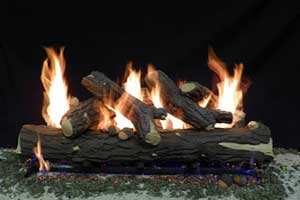 Imagine coming home after a hard day of work and sitting down next to a cozy fire in your fireplace, and relaxing with a cup of soothing tea or a glass of Merlot, all in just a matter of minutes, with minimal effort. Think this is impossible? With gas logs in your fireplace, this is totally possible. But you need to know all the facts about gas logs in order to make an informed decision.
Imagine coming home after a hard day of work and sitting down next to a cozy fire in your fireplace, and relaxing with a cup of soothing tea or a glass of Merlot, all in just a matter of minutes, with minimal effort. Think this is impossible? With gas logs in your fireplace, this is totally possible. But you need to know all the facts about gas logs in order to make an informed decision.
Advantages of Gas Logs
Time Savings and Ease of Use
Gas logs are instant on/instant off. You can light a fire within seconds. Even better, at the end of the evening, there’s no waiting for the wood embers to finish burning out before going to bed like you need to do when burning wood.
Clean Burning to the Environment
Gas logs don’t produce many particulates and therefore are very clean burning to the environment.
Beautiful Display
Gas logs are very realistic looking and make a cozy display even when the gas logs aren’t on.
Less Work
No more lugging in the firewood from outside and no more cleaning out the debris from the firebox after a wood-burning fire. This makes it ideal for older people who may find it difficult to carry in the heavy wood or bend down to clean out the fireplace.
Less Maintenance
Gas logs produce minimal creosote build-up in the flue, which means that a chimney sweeping is not required as often as wood-burning fireplaces. However, according to the National Fire Protection Guideline 13:2, this code requires that “Chimneys, fireplaces and vents shall be inspected at least once a year…cleaning maintenance and repairs shall be done if necessary.”
Termite- and Rodent-Free
Woodpiles can attract termites and rodents which isn’t a problem with gas logs. On a similar note, woodpiles should never be located up against a house.
Absolutely No Hassle
You never have to clean out the ashes and debris from the fireplace. In fact, we highly recommend that you never even touch the gas logs after they’ve been installed. The logs have to be positioned in a very specific way on the grate and then tested with a special combustible gas detector to ensure the gas logs are positioned correctly.
Available Space
Not everybody has a backyard with space for a cord of wood. In addition, not all homeowner associations permit woodpiles. This is especially true for people who live in condominiums or urban areas.
Disadvantages of Gas Logs
Heat Loss from the Home
Uniform Mechanical Code and the gas log manufacturers’ instructions require that the fireplace’s damper be locked permanently in a FULLY open position. If you don’t have glass doors on the front of your fireplace, an open damper is equivalent to an open window and you will lose heat from your home during the winter. In fact, every time your central heater or furnace kicks on, all you’re doing is sucking cold air down your chimney and into the room which totally defeats the whole purpose of having your furnace on. This also holds true in the summertime. With an open damper and no glass doors, every time your air conditioner kicks on, all you’re doing is sucking hot air down your chimney and into the room.
The solution to an open damper is glass doors in front of the fireplace, but not all fireplaces can have glass doors, especially prefab fireplaces where the manufacturer may not have listed glass doors available for that system. Therefore the glass door solution won’t always work for all fireplaces.
In some states and regions in the United States, ventless gas logs are allowed which doesn’t have the requirement of the locked-open damper.
Less Heat Generated
In most cases, gas logs don’t produce the heat that burning wood does, although some manufacturers’ logs may produce more heat than others. Gas logs are not designed so much for heat as for appearance, ambiance and romance.
To compensate for the lack of heat from gas logs, many people will turn on the furnace to get the heat that they’re not getting from the fireplace. Having both the gas logs and the furnace on at the same time is not a good idea. You may lose the draw on the fireplace which means that instead of the gases going up the flue, the gases can be drawn into the room. (To what extent this can happen depends on how tight the house is and where the air intake is for the furnace.) The rule of thumb for fireplaces and furnaces: One on at a time; never on at the same time.
Dependency on Utility Company
Gas logs mean that you’re dependent on the utility company for natural gas or the propane company for propane.
No crackling Sound
Although many gas log sets have a very realistic look, there are no gas log sets on the market that produce a wood crackling sound.
In Summary…
Making the decision for gas logs doesn’t have to be difficult once you know all the facts. There are many factors to take into consideration but information is power in deciding between burning wood or gas logs.
